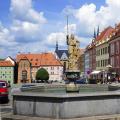LECTURE 15
The composition of the agro-industrial complex, its role in the country's economy, the need for reform. Economic and geographical characteristics of the leading sectors of the complex - agriculture and Food Industry... Development prospects.
Agro-industrial complex(Agro-industrial complex) is the largest intersectoral complex in the country. This is a system of interconnected industries for the production, processing and delivery of agricultural products to the consumer, as well as for the maintenance of agricultural production and enterprises for the processing of agricultural raw materials. The composition of the agro-industrial complex can be considered in two versions: with full coverage of all interrelated industries and types of production and services; covering only the main industries that form the core of the agro-industrial complex.
Prospects for the development of the agricultural sector
Major agricultural commodities and products include rice, rubber, corn, vegetables and fruits, and cassava. This growth was largely driven by large surges in the crop production of rice, corn, cassava, sugarcane and vegetables. Prices were also cut for other products, including rubber and corn.
A number of Cambodian products have an international reputation High Quality... Campo pepper has the status of a geographical indication, an initiative of the World Trade Organization that links the quality of a product with its origin. However, there are major obstacles to be overcome in developing the agricultural sector, building processing industries and ensuring significant export growth.
According to the first, full version, the agro-industrial complex includes the following four groups of industries and industries, which represent various functional links of the agro-industrial complex:
· Agriculture itself as a basic branch of the agro-industrial complex. These are plant growing and animal husbandry of agricultural enterprises, farms, as well as personal subsidiary plots of collective farmers, workers and employees; its function is the production of agricultural products;
There are large differences in what can be earned from different cultures, and World Bank studies show that different changes can lead to some changes in Cambodia. There are also changes in rice production. More farmers produce aroma paddies, which is more profitable. Production is estimated at 10 percent of the area of rice cultivated and 30 percent of total production.
Agricultural and bioproduct industry
Five sectors with fertile futures
Organic farming and value-added processing. ... Berries in general are also very popular with consumers. This growing niche is enjoying steady growth. There is also a well-diversified industry for cow's milk cheeses.Balanced approach to farming
The region has excellent potential for sustainable development of its agricultural sector.· Branches (sub-branches) producing various products from agricultural raw materials. This is the food industry and primary processing of agricultural raw materials for light industry(flax factories, leather factories, fur factories); its function is the processing of agricultural products and the production of food and non-food consumer goods;
This real food consisted of whole fruits and vegetables, eaten in season or preserved during the summer months during the long, cold winter. Real food came from animals that grazed in the pasture, and they were allowed to live by their natural instincts, scratching, pecking, giving birth and wandering at will.
But now industrial agriculture has taken over our food supply. In an effort to feed more people in an easier and more productive way, food has become food "staple" full of chemicals rather than real food. This denatured food contributes to diseases that shorten a person's life span for the first time. Obesity, cancer, heart disease, high blood pressure, and diabetes are always high, and most of these diseases are controlled by the food we eat.
· Industries and services that provide agriculture and industries that process agricultural raw materials, means of production, material resources; carrying out production and technical maintenance and providing services to the branches of the agro-industrial complex. These are tractor and agricultural engineering, repair of machines, production of machinery and equipment for food and partly light industry, production of mineral fertilizers and chemical plant protection products, microbiological industry;
How does the current industrial food system affect your health?
Americans spend about ninety percent of their food budget on processed foods, which, unlike whole foods, have been processed in some way after being harvested or destroyed. Almost all of these processed foods contain additives, substances designed to alter the food in some way before they are sold to consumers.
Bacteria are everywhere, including on the skin and in the human digestive system. Although bacteria are critical to normal body functions, some types can cause disease. In humans, antibiotics are used to treat health conditions caused by bacteria, including ear and skin infections, food poisoning, pneumonia, meningitis, and other serious illnesses. Antibiotics are also used to treat or prevent infections that can complicate critical medical procedures, including surgery, cancer therapy, and transplantation.
· Infrastructure subcomplex: procurement of agricultural raw materials, their transportation and storage, trade in food products and catering, personnel training, construction in the agro-industrial complex, research organizations.
With this approach, the main sign of attributing a particular industry or service to the agro-industrial complex should be considered its direct connection with agriculture - the basic industry of the complex, and then the agro-industrial complex concentrates more than a third of the country's entire production potential.
Significant corporate consolidation of global food production has created a food system that values quantity over quality. Every decision a farmer or corporation makes to grow or grow a particular type of food affects the final product. Reducing angles in animal feed quality, waste management, farm worker training, handling and distribution methods affect the safety of our food.
Scientists estimate that about two-thirds of American cattle raised for slaughter today are injected with hormones to make them grow faster. These measures mean higher margins for beef, but what does this mean for consumers? Pesticides are chemical substances used to destroy or control various agricultural pests that can damage crops and livestock, as well as reduce agricultural productivity. The most commonly used pesticides are insecticides, herbicides, rodenticides and fungicides.
According to the second option, out of the entire composition of the complex, only two main links are considered - agriculture (i.e., production of crop and livestock products) and the food industry.
As has already been noted many times, there are no clear boundaries between the IOCs, they are all interconnected and individual links can be part of different IOCs. Thus, the production of means of production for the agro-industrial complex has already been considered as part of other complexes - machine-building (agricultural machine-building and tractor-building, production of reclamation machines, equipment for the food industry) and chemical (production of mineral fertilizers, microbiological industry). The complex for the production of consumer goods includes flax factories, leather factories, fur factories, infrastructure - in the corresponding complexes (transport, construction, etc.). Therefore, the agro-industrial complex in this lecture is considered according to the second option - as part of two main sectors - agriculture and the food industry. These two subdivisions of the country's economy produce 14% of GDP (2001), their share in the number of people employed in the economy is 16.2% (712 thousand people).
Of these, herbicides are the most widely used. More than 1 billion tons of pesticides are used annually in the United States today. Despite opposition from scientists, farmers and consumers, the United States is now allowing dairy cows to receive recombinant bovine growth hormone, also known as recombinant bovine somatotropin.
Buy local, sustainable and organic. Center and business location. For business flights, the Stendhal-Borstel airfield is available, and the area can be reached by water via the Tangermünde harbor on the Elbe. The economic structure is characterized by small and medium-sized enterprises. At the University of Applied Sciences Magdeburg-Stendal, located in Stendal, the district has a facility with high economic know-how and a strong potential of skilled workers.
The role of the agro-industrial complex in economic complex It is determined not so much by the above quantitative indicators, but by the fact that this complex should ensure the country's food security, supplying the population with food both directly consumed in fresh form and after processing at food industry enterprises. For many years, the agro-industrial complex of Belarus has also been a supplier outside the republic of a significant amount of meat, dairy and fruit and vegetable products, potatoes and flax fiber.
Many municipalities have affordable, low-cost commercial and industrial areas on an equal footing for new companies. Powerful agriculture, developed industry. Due to natural conditions, agriculture is a significant sector of the economy. Processing of agricultural products, as well as industries of steel and mechanical engineering, metalworking and processing, food and woodworking industries, glass industry and processing, construction Vehicle, shipbuilding and environmental technology is a successful development.
The programs currently being implemented for reforming the agro-industrial complex are aimed at increasing its efficiency, at cooperation and integration of interrelated structures, improving the management of the agro-industrial complex (in particular, reducing numerous management and service organizations), at forming product technological chains that integrate the production of agricultural raw materials, its processing, branded trade and sales, as well as including financial structures, logistics and service enterprises. At the same time, the main factor in increasing the efficiency of the entire agro-industrial complex remains the increase in the efficiency of its basis - agriculture.
Omnipresent history and pure nature. The Stendal area is rich in sights and unspoiled nature. The structure of the landscape is varied. The visitor will visit a cultural landscape of a special character with high experience and recreational value. Churches, gates, towers and town halls bear witness to a rich history of the former wealth of their cities. Old city Stendhal is as important as Havelberg or Tangermünde. Centuries are worth a visit. The Stendal area is also a paradise for nature lovers.
Among the unusual proposals are, for example, the observation of storks and the Elbe crossing on the Borzai. But farm holidays are also very popular. Crete has little mineral wealth, and if so, only in small quantities. You also cannot find manufacturing facilities on the island. The location and structure unfavorable to traffic are unlikely to lead to this. Only in the Greater Heraklion area is there a small industry that processes local products such as olives and grapes.
Rural economy – leading branch of the agro-industrial complex. Although the volume of agricultural production is still almost 30% lower than the volume of 1990, Belarus ensures its food security (see Table 12) and remains the leader among the CIS countries in the production of the main types of agricultural products per capita. So, in 2001, Belarus in the CIS ranked first in the production of potatoes (779 kg), meat (63 kg), milk (485 kg) and the fifth in grain production (517 kg).
In addition, the growing tourism has also stimulated the construction of new homes and facilities, with some construction companies offering jobs for Cretans. Meanwhile, Crete already plays an important role in the Greek economy. After all, almost a fifth of all Greek income comes from this island.
However, due to limited employment opportunities in industry, a large proportion of the population still lives in agriculture. Although only a quarter of all Greeks work in agriculture, Crete is said to account for more than half of all workers, although statistically these figures are only partly correct, since Cretans are usually more than employed.
At the same time, today's agriculture is the most problematic sector of the economy, in which (2001) the majority of enterprises (68.5%) are unprofitable, the depreciation of fixed assets as a whole has reached 57.2%, and machinery and equipment - 79.3%, have worsened compared to 1990. all volumetric and quality indicators. So, if in 1990. the share of agriculture in GDP was 22.9%, and in the number of employed in the economy 19% (915 thousand people). - 8.9% and 13.3%, respectively (585 thousand people). If in 1990. profitability of agricultural enterprises was 42.6%, then in 2000. - only 3%, and in 2001. became negative (-6%), i.e. unprofitable. Therefore, the industry is in dire need of reform.
Only about a third of the total land area in Crete can be used for agriculture. Rocky, nutrient-free soils and hilly areas make management difficult land resources... In addition, water shortages are common. In addition to olives, Crete is rich in vegetables and fruits of various types, most of which are exported to Central Europe... Cereals and potatoes barely grow. Today Crete must import grain, and in ancient times the island was considered the granary of the region.
Like hundreds of years ago, olives and wine are still the source of wealth and prosperity in Crete. More than a thousand tons of olive oil are exported annually to Central Europe, with about the same consumed on the island itself. Oranges, tangerines and lemons come mainly from plantations on the west north coast. However, a specialty in Crete is bananas, which are a special variety, small, strong and sweet. This banana variety comes from the Middle East and is grown in greenhouses in the eastern part of the island.
The agro-industrial complex in its composition and structure differs significantly from other intersectoral complexes, primarily because it uses the land as the main means of production on which agricultural products and raw materials are grown for industrial and non-industrial consumption. Agricultural production based on the use of agricultural land serves as the basis for the development of processing industries. The agro-industrial complex largely determines the socio-economic development of the country, the standard of living of the population, its provision with food, and industry - with agricultural raw materials. The solution to the food problem is carried out mainly in the agro-industrial complex. It is because of this that it is an important link in the economy and should have priority development.
The plant of vegetables and bananas grows every year and, unfortunately, comes with heavy use of fertilizers and pesticides. Livestock raising of sheep and goats also became an important branch of the economy, with almost half of the island being available as grazing land. However, about 000 goats and 000 sheep are faced with fewer than 000 cattle and 000 pigs.
Dwindling fish stocks in the Mediterranean region threaten the once proud fishery. The Aegean Sea is largely empty, and fish imports have reached enormous proportions, so most of the seafood served is not from the waters around Crete.
The agro-industrial complex is a complex complex in which many industries and industries are economically, technologically and organizationally interconnected. The agro-industrial complex has a very complex functional and sectoral structure.
It consists of 3 main areas:
1) Agricultural production - plant growing and animal husbandry, which create the raw material base of the agro-industrial complex. This is its main base link.
The main source of income in Crete is of course tourism. More than 2 million guests are expected and cared for annually. With a population of 000 people, every Cretan 3 tourists do this. More than half of all hotel beds are located in the Heraklion area, in Chani about a quarter, and the Rethymnon and Lassithi areas account for the remaining 25%.
Numerous gift shops, taverns, travel agencies, car rentals, travel guides, room providers, hotel staff, etc. - all this is lived almost exclusively by numerous tourists. 300 days of sunshine a year, beautiful landscape, mountains, sea, culinary delights are the basis of the island's attraction as a holiday magnet.
2) Branches that create material and technical means for the branches of the agro-industrial complex. These are agricultural engineering, the production of plant protection products, mineral fertilizers, the feed and microbiological industry, the production of containers, special equipment and instruments for the agro-industrial complex, etc.
3) Branches providing the processing of agricultural products - agricultural raw materials and food (food, light).
In addition to these main areas, the agro-industrial complex includes industrial and social infrastructure in the part that works for the needs of the complex. This includes transport, warehousing, material and technical supplies, engineering structures, information support, specialized trade, housing and communal services, medical services, etc.
According to production characteristics, the agro-industrial complex includes food and non-food complexes.
Food complex Is a set of industries related to the production of food products of plant and animal origin. This also includes industries that technologically do not belong to agriculture. This is the production of salt mineral waters, fish catch, etc.
To the non-food complex include industries associated with the production of consumer goods from raw materials of plant and animal origin; branches of light industry, primarily those that are engaged in the primary processing of agricultural raw materials.
In turn, these complexes, depending on the type of raw materials used, are divided into crop and livestock subcomplexes .
A special role in the agro-industrial complex is played by the food complex, which provides the population with food. It includes industries related only to food production. This complex includes grain, potato, sugar beet, fruit and vegetable, grape and wine, meat, dairy, fat and oil subcomplexes.
Territorial structure The agro-industrial complex is formed on a specific territory in the form of different forms agro-industrial integration... In the scientific literature, local and regional agro-industrial complexes are distinguished. Local agro-industrial complexes were formed on relatively small territories on the basis of the amalgamation of agro-industrial enterprises for processing low-transportable products and have the lowest degree of integration. These are the most common forms of AIC. Among them, there are: an agro-industrial point, an agro-industrial center, an agro-industrial bush, an agro-industrial hub.
Placement of plant growing industries. The location of plant growing industries depends to a large extent on the sown areas, their structure and rational use. The share of crop industries in the value of all agricultural products is more than 50%.
The most favorable for plant growing are the steppe and forest-steppe zones.
The sown areas of Ukraine in 1997 amounted to 30.3 million hectares, including grain crops - 14.1, industrial - 3.7, potatoes and melons - 2.1, fodder crops - 10.9 million hectares. Net vapor area - 2 mln.
Cereals v last years occupy 42-47% of the sown area. The main zones of grain production are the Steppe and Forest-Steppe, where up to 85% of their total volume is produced. Ukraine produces almost all grain crops, according to the structure of crops it is divided into zones, which is associated with different natural and economic conditions.
Industrial crops in Ukraine, they occupy about 11% of the sown area. These are sugar beets, sunflowers, fiber flax, hemp, tobacco, hops, essential oil and medicinal plants.
Distributed throughout the territory vegetable growing and melon growing , which is zoned according to the yield of certain types of crops. So, tomatoes, eggplants, peppers, melons are grown mainly in the southern regions, cucumbers - in the northern regions of the Forest-steppe and Polesie.
Gardening and viticulture distributed in the southern regions, Transcarpathia, Forest-steppe.
Placement of livestock industries. Animal husbandry supplies the population with high-quality food products, supplies raw materials for the light, food and pharmaceutical industries, and organic fertilizers. Industry placement is influenced by natural conditions, forage production resources and natural forage lands. The location and specialization of animal husbandry are determined in most cases by the needs of the population and the transportability of products. Certain branches of animal husbandry are tied to meat, sugar, alcohol and other types of industry. V sectoral structure the main role is played by cattle breeding, pig breeding, poultry farming and sheep breeding.
The main agricultural zones of Ukraine. In Ukraine, depending on the natural, economic and historical conditions, there are three main zones of specialization of agriculture: Polesie, Forest-steppe and Steppe, as well as before mountainous regions Crimea and the Carpathians.
Polissya agricultural zone occupies the north of Ukraine - Zhytomyr, Rivne, Volyn regions, the north of Kiev, Chernigov and Sumy regions and gives a quarter of meat and milk, three quarters of flax fiber, a third of potatoes and a tenth of grain (rye, buckwheat, wheat and oats).
Forest-steppe(part of Lvov and Chernivtsi regions, east of Ivano-Frankivsk, Khmelnytsky, Vinnytsia, north of Cherkasy, Kirovograd, Poltava and Kharkov regions) with a sugar-beet-grain zone, meat and dairy cattle breeding and pig breeding. The main grain crop is wheat, there is also corn, barley, buckwheat, millet. Vegetables and potatoes, gardening are widespread.
Steppe zone occupies 40% of the territory of Ukraine, covering all southern branches with grain and oilseeds, vegetable growing, melon growing, dairy and meat cattle breeding, pig and sheep breeding. The bulk of the country's commercial grain is produced here.
Foothills and mountainous regions of the Carpathians specialize in cattle. There are crops of oats, corn, rye, wheat, etc. In Transcarpathia, winter wheat, corn, tobacco are sown, there is gardening and viticulture, productive livestock.
Foothills and mountain regions of Crimea occupy the south of the peninsula. Specialization - animal husbandry and especially sheep breeding. Horticulture, vegetable growing, viticulture are developed in the valleys and foothills, essential oil crops are grown. Vegetable and dairy zones are being formed around big cities.
Placement of branches of primary processing of agricultural raw materials. These industries include meat, dairy, sugar, flour and cereals, canning, butter and starch and syrup. The most important factors the location of the food industry are the size and density of the population, raw material base, forms of organization of production, transport. Natural conditions and scientific and technological progress objectively influence the location of the food industry. Depending on the influence of the main factors, the primary processing industries of agricultural raw materials are divided into three groups:
Focused on the sources of raw materials (sugar, alcohol, canning, fruit and vegetable, butter industry);
Gravitating to places of consumption of finished products (bakery, brewing, pasta, dairy, confectionery);
Focused on both raw materials and consumers (meat, flour, tobacco).
To determine the main factor, cost rates and the share of raw materials in comparison with finished products are taken into account.




